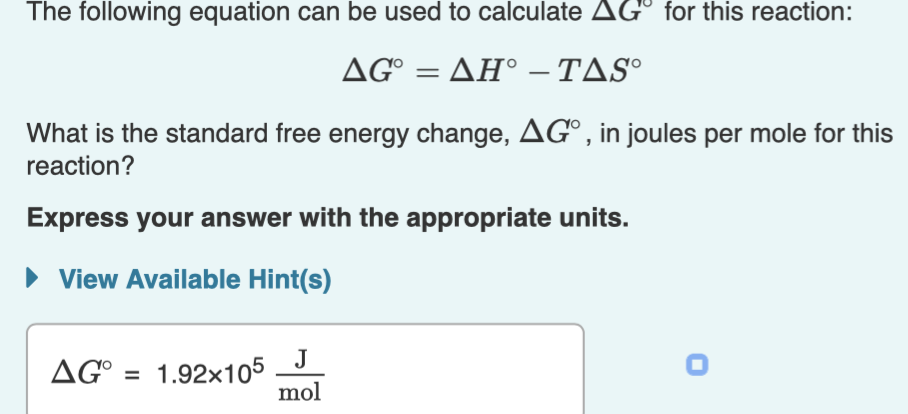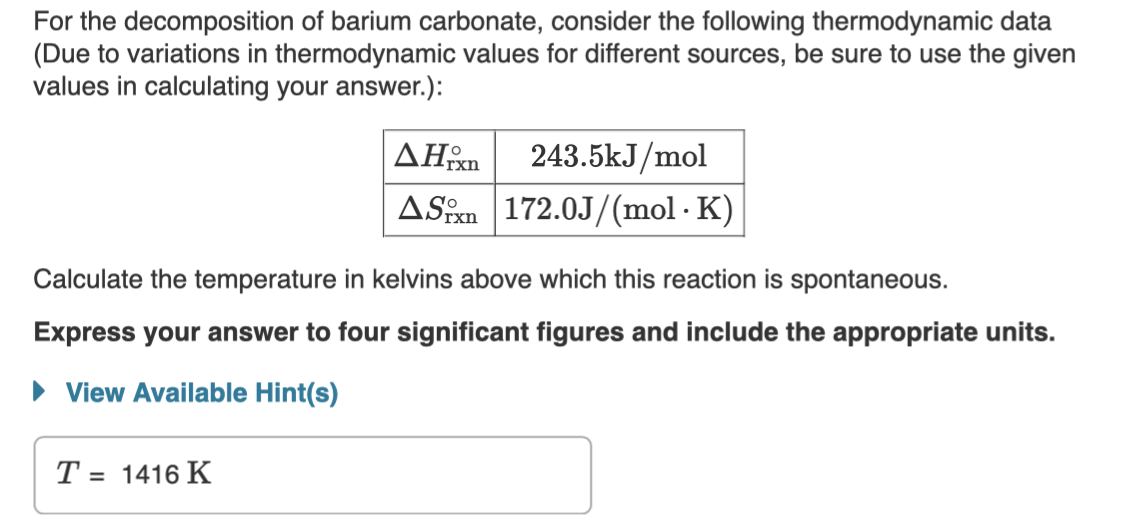The thermodynamic values from part A will be useful as you work through part B: ΔH∘rxn 243.5kJ/mol ΔS∘rxn 172.0J/(mol⋅K) Calculate the equilibrium constant for the following reaction at room temperature, 25 ∘C BaCO3(s)→BaO(s)+CO2(g)
The thermodynamic values from part A will be useful as you work through part B: ΔH∘rxn 243.5kJ/mol ΔS∘rxn 172.0J/(mol⋅K) Calculate the equilibrium constant for the following reaction at room temperature, 25 ∘C BaCO3(s)→BaO(s)+CO2(g)
Chemistry for Engineering Students
4th Edition
ISBN:9781337398909
Author:Lawrence S. Brown, Tom Holme
Publisher:Lawrence S. Brown, Tom Holme
Chapter10: Entropy And The Second Law Of Thermodynamics
Section: Chapter Questions
Problem 10.91PAE: The reaction shown below is involved in the refining of iron. (The table that follows provides all...
Related questions
Question
The
| ΔH∘rxn | 243.5kJ/mol |
| ΔS∘rxn | 172.0J/(mol⋅K) |
Calculate the equilibrium constant for the following reaction at room temperature, 25 ∘C
BaCO3(s)→BaO(s)+CO2(g)

Transcribed Image Text:The following equation can be used to calculate AGº for this reaction:
ΔG ΔΗ-ΤΔS
What is the standard free energy change, AG°, in joules per mole for this
reaction?
Express your answer with the appropriate units.
• View Available Hint(s)
J
AG° = 1.92x105
mol
AG° :
%3D

Transcribed Image Text:For the decomposition of barium carbonate, consider the following thermodynamic data
(Due to variations in thermodynamic values for different sources,
values in calculating your answer.):
be sure to use the given
AHm
243.5kJ/mol
ASPn 172.0J/(mol · K)
xn.
Calculate the temperature in kelvins above which this reaction is spontaneous.
Express your answer to four significant figures and include the appropriate units.
• View Available Hint(s)
T = 1416 K
%3D
Expert Solution
This question has been solved!
Explore an expertly crafted, step-by-step solution for a thorough understanding of key concepts.
This is a popular solution!
Trending now
This is a popular solution!
Step by step
Solved in 2 steps

Knowledge Booster
Learn more about
Need a deep-dive on the concept behind this application? Look no further. Learn more about this topic, chemistry and related others by exploring similar questions and additional content below.Recommended textbooks for you

Chemistry for Engineering Students
Chemistry
ISBN:
9781337398909
Author:
Lawrence S. Brown, Tom Holme
Publisher:
Cengage Learning

General Chemistry - Standalone book (MindTap Cour…
Chemistry
ISBN:
9781305580343
Author:
Steven D. Gammon, Ebbing, Darrell Ebbing, Steven D., Darrell; Gammon, Darrell Ebbing; Steven D. Gammon, Darrell D.; Gammon, Ebbing; Steven D. Gammon; Darrell
Publisher:
Cengage Learning

Chemistry by OpenStax (2015-05-04)
Chemistry
ISBN:
9781938168390
Author:
Klaus Theopold, Richard H Langley, Paul Flowers, William R. Robinson, Mark Blaser
Publisher:
OpenStax

Chemistry for Engineering Students
Chemistry
ISBN:
9781337398909
Author:
Lawrence S. Brown, Tom Holme
Publisher:
Cengage Learning

General Chemistry - Standalone book (MindTap Cour…
Chemistry
ISBN:
9781305580343
Author:
Steven D. Gammon, Ebbing, Darrell Ebbing, Steven D., Darrell; Gammon, Darrell Ebbing; Steven D. Gammon, Darrell D.; Gammon, Ebbing; Steven D. Gammon; Darrell
Publisher:
Cengage Learning

Chemistry by OpenStax (2015-05-04)
Chemistry
ISBN:
9781938168390
Author:
Klaus Theopold, Richard H Langley, Paul Flowers, William R. Robinson, Mark Blaser
Publisher:
OpenStax

Chemistry
Chemistry
ISBN:
9781305957404
Author:
Steven S. Zumdahl, Susan A. Zumdahl, Donald J. DeCoste
Publisher:
Cengage Learning


Chemistry: An Atoms First Approach
Chemistry
ISBN:
9781305079243
Author:
Steven S. Zumdahl, Susan A. Zumdahl
Publisher:
Cengage Learning